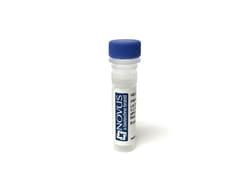Alkaline Phosphatase, Tissue Non-Specific Antibody (V17.1) - Azide and BSA Free, Novus Biologicals™
Mouse Monoclonal Antibody
Manufacturer: Fischer Scientific
The price for this product is unavailable. Please request a quote
Antigen
Alkaline Phosphatase, Tissue Non-Specific
Concentration
1.0 mg/mL
Applications
Flow Cytometry, Immunohistochemistry (Frozen), Immunofluorescence, CyTOF
Conjugate
Unconjugated
Host Species
Mouse
Target Species
Human, Primate
Gene Alias
Alkaline phosphatase liver/bone/kidney isozyme, alkaline phosphatase, liver/bone/kidney, alkaline phosphatase, tissue-nonspecific isozyme, alkaline phosphomonoesterase, APTNAP, AP-TNAP, EC 3.1.3.1, FLJ40094, FLJ93059, glycerophosphatase, HOPS, liver/bone/kidney-type alkaline phosphatase, MGC161443, tissue-nonspecific ALP, TNAP, TNSALPMGC167935
Gene Symbols
ALPL
Isotype
IgG1 κ
Purification Method
Protein A or G purified
Test Specificity
There are at least four distinct but related alkaline phosphatases: intestinal, placental, placental-like, and liver/bone/kidney (tissue non-specific). The first three are located together on chromosome 2, while the tissue non-specific form is located on chromosome 1. The product of this gene is a membrane bound glycosylated enzyme that is not expressed in any particular tissue and is, therefore, referred to as the tissue-nonspecific form of the enzyme. The exact physiological function of the alkaline phosphatases is not known. A proposed function of this form of the enzyme is matrix mineralization; however, mice that lack a functional form of this enzyme show normal skeletal development. This enzyme has been linked directly to hypo-phosphatasia, a disorder that is characterized by hypercalcemia and includes skeletal defects. The character of this disorder can vary, however, depending on the specific mutation since this determines age of onset and severity of symptoms. Alternatively spliced transcript variants, which encode the same protein, have been identified for this gene.
Clone
V17.1
Dilution
Flow Cytometry : 0.5 - 1 ug/million cells in 0.1 ml, Immunohistochemistry-Frozen : 0.5 - 1.0 ug/ml, Immunofluorescence : 0.5 - 1.0 ug/ml, CyTOF-ready
Classification
Monoclonal
Form
Purified
Regulatory Status
RUO
Formulation
PBS with No Preservative
Gene ID (Entrez)
249
Immunogen
Bovine intestinal alkaline phosphatase
Primary or Secondary
Primary
Content And Storage
Store at 4C short term. Aliquot and store at -20C long term. Avoid freeze-thaw cycles.
Molecular Weight of Antigen
55 kDa
Description
- Alkaline Phosphatase, Tissue Non-Specific Monoclonal specifically detects Alkaline Phosphatase, Tissue Non-Specific in Human, Bovine samples
- It is validated for Flow Cytometry, Immunohistochemistry, Immunocytochemistry/Immunofluorescence, Immunohistochemistry-Paraffin, Immunohistochemistry-Frozen, Immunofluorescence, CyTOF-ready.
